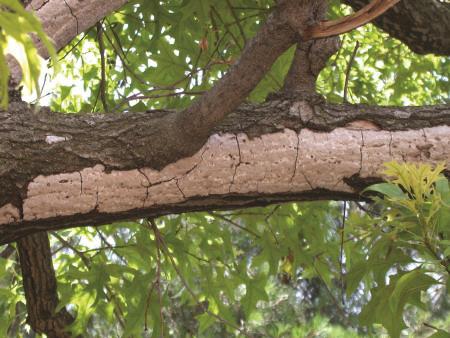Disease Gallery
Disease Details
Hypoxylon Canker
Hypoxylon atropunctatum
Though this fungus occurs on oaks in Oklahoma, it has not been found on pecans. Stressed trees, particularly those that are water stressed, will very likely become infected. There is no control of the fungus once it infects a tree. The problem can be prevented by maintaining a proper balance of water in the root zone, painting over wounds, preventing compaction of soil around trees, avoiding cultivation around trees, and maintaining a satisfactory rate of growth by fertilization.
Research reports indicate that the organism enters branches through wounds. The fungus then grows through the wounds, then through the sapwood causing decay. The first outward symptoms that may be evident are yellowing and wilting of leaves and death of top branches. Inoculation experiments in Georgia have shown that the fungus is capable of spreading up to 3 feet above and below a point of inoculation within one growing season. Researchers at the University of Arkansas have been able to isolate the fungus from seedling oak trees which showed no symptoms of infection. This would indicate that the fungus may be active in the trees for a number of years before disease symptoms are noticed. When trees are weakened, particularly by drought, or injured, the disease is capable of overcoming resistance of the host, and the tree dies. The disease progresses through branches, causing dieback symptoms. After the death of branches or of the tree, the outer bark sloughs off, exposing a thin stroma (a mass or mat of fungal hyphae packed together to form a hard crust in or on which spores are formed). At first the stroma produces brownish, dusty masses of conidia (asexual fungus spores) that are easily blown from tree to tree and which cause new infections. The stroma color soon changes to silver and then to black as the sexual state of the fungus develops. The stroma becomes thicker and harder as the sexual state develops. The sexual state produces masses of dark spores inside the stroma, which are “oozed” out onto the surface, where they can be transferred by various means (rain, insects, etc.) to other branches or trees. A large tree may be killed within one to two years, depending on the vigor of the tree; however, because early stages of the disease may not be noticed, trees may appear to die within a period of a few weeks. A stroma may be limited in its development or may extend the entire length of the tree.
The disease is characterized by sloughing off of bark and a reddish powdery substance formed on the wood under the bark. This should not be confused with the normal red powdery material formed on the underside of the bark itself. A chocolate brown to black crusty substance will eventually form on infected wood. Infected limbs and trunks will eventually die.
